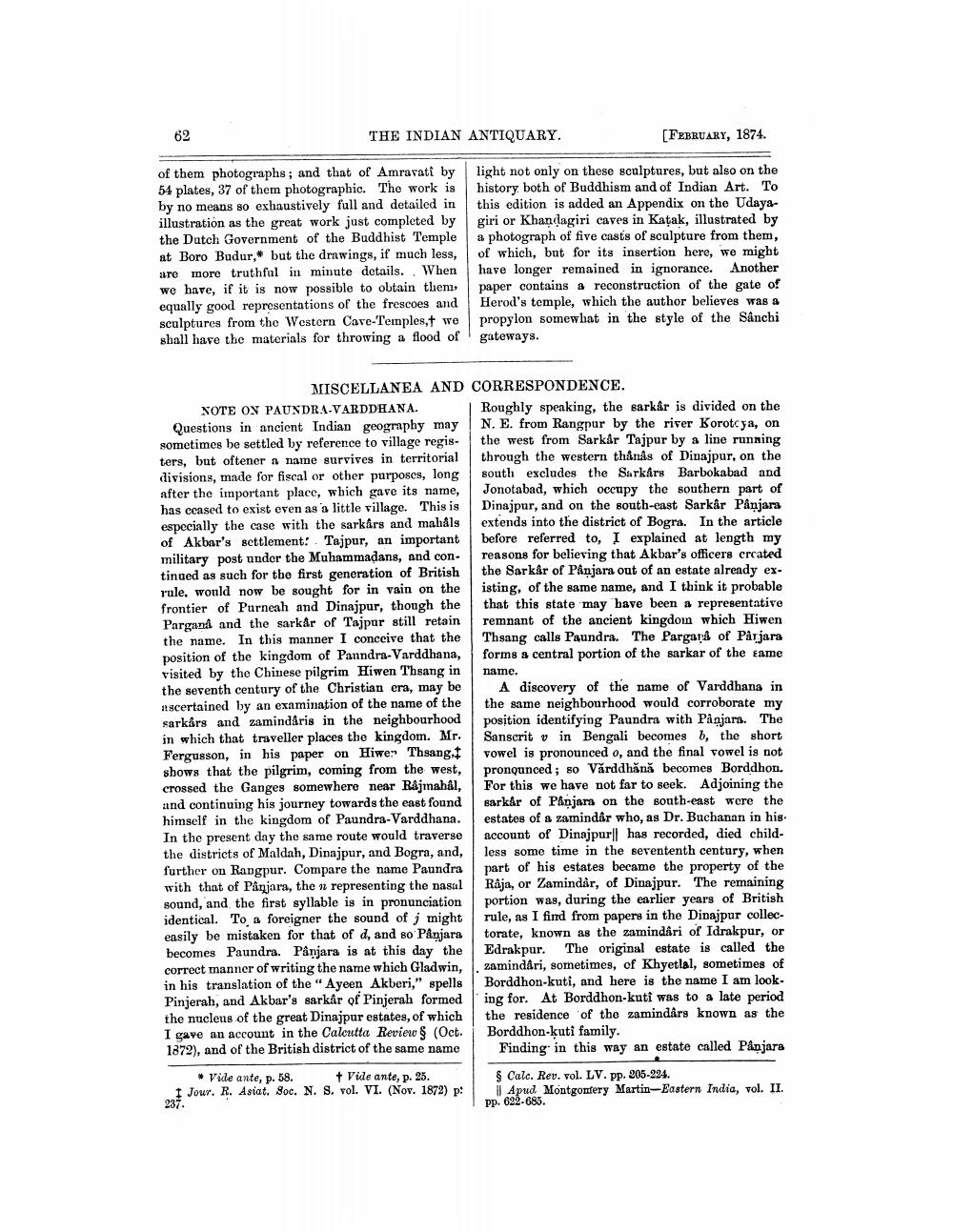________________
62
THE INDIAN ANTIQUARY.
of them photographs; and that of Amravati by 54 plates, 37 of them photographic. The work is by no means so exhaustively full and detailed in illustration as the great work just completed by the Dutch Government of the Buddhist Temple at Boro Budur, but the drawings, if much less, are more truthful in minute details. When we have, if it is now possible to obtain them, equally good representations of the frescoes and sculptures from the Western Cave-Temples,† we shall have the materials for throwing a flood of
[FEBRUARY, 1874.
light not only on these sculptures, but also on the history, both of Buddhism and of Indian Art. To this edition is added an Appendix on the Udayagiri or Khandagiri caves in Katak, illustrated by a photograph of five casts of sculpture from them, of which, but for its insertion here, we might have longer remained in ignorance. Another paper contains a reconstruction of the gate of Herod's temple, which the author believes was a propylon somewhat in the style of the Sânchi gateways.
MISCELLANEA AND
NOTE ON PAUNDRA-VARDDHANA. Questions in ancient Indian geography may sometimes be settled by reference to village registers, but oftener a name survives in territorial divisions, made for fiscal or other purposes, long after the important place, which gave its name, has ceased to exist even as a little village. This is especially the case with the sarkars and mahåls of Akbar's settlement: Tajpur, an important military post under the Muhammadans, and continued as such for the first generation of British rule, would now be sought for in vain on the frontier of Purneah and Dinajpur, though the Pargana and the sarkar of Tajpur still retain the name. In this manner I conceive that the position of the kingdom of Panndra-Varddhana, visited by the Chinese pilgrim Hiwen Thsang in the seventh century of the Christian era, may be ascertained by an examination of the name of the sarkârs and zamindâris in the neighbourhood in which that traveller places the kingdom. Mr. Fergusson, in his paper on Hiwe Thsang, shows that the pilgrim, coming from the west, crossed the Ganges somewhere near Rajmahal, and continuing his journey towards the east found himself in the kingdom of Paundra-Varddhana. In the present day the same route would traverse the districts of Maldah, Dinajpur, and Bogra, and, further on Rangpur. Compare the name Paundra with that of Pânjara, the n representing the nasal sound, and the first syllable is in pronunciation identical. To a foreigner the sound of j might easily be mistaken for that of d, and so Pânjara becomes Paundra. Pânjara is at this day the correct manner of writing the name which Gladwin, in his translation of the "Ayeen Akberi," spells Pinjerah, and Akbar's sarkâr of Pinjerah formed the nucleus of the great Dinajpur estates, of which I gave an account in the Calcutta Review § (Oct. 1872), and of the British district of the same name
*Vide ante, p. 58.
+ Vide ante, p. 25. Jour. R. Asiat. Soc. N. S. vol. VI. (Nov. 1872) p:
237.
CORRESPONDENCE.
Roughly speaking, the sarkâr is divided on the N. E. from Rangpur by the river Korotcya, on the west from Sarkâr Tajpur by a line running through the western thânâs of Dinajpur, on the south excludes the Sarkars Barbokabad and Jonotabad, which occupy the southern part of Dinajpur, and on the south-east Sarkâr Pânjara extends into the district of Bogra. In the article before referred to, I explained at length my reasons for believing that Akbar's officers crcated the Sarkar of Pânjara out of an estate already existing, of the same name, and I think it probable that this state may have been a representative remnant of the ancient kingdom which Hiwen Thsang calls Paundra. The Pargará of Pârjara forms a central portion of the sarkar of the same
name.
A discovery of the name of Varddhana in the same neighbourhood would corroborate my position identifying Paundra with Panjara. The Sanscrit in Bengali becomes b, the short vowel is pronounced o, and the final vowel is not pronounced; so Varddhănă becomes Borddhon. For this we have not far to seek. Adjoining the sarkár of Panjara on the south-east were the estates of a zamindâr who, as Dr. Buchanan in his. account of Dinajpur has recorded, died childless some time in the sevententh century, when part of his estates became the property of the Râja, or Zamindar, of Dinajpur. The remaining portion was, during the earlier years of British rule, as I find from papers in the Dinajpur collectorate, known as the zamindâri of Idrakpur, or Edrakpur. The original estate is called the zamindâri, sometimes, of Khyetlal, sometimes of Borddhon-kuti, and here is the name I am looking for. At Borddhon-kuti was to a late period the residence of the zamindars known as the Borddhon-kuti family.
Finding in this way an estate called Pânjara
§ Calc. Rev. vol. LV. pp. 205-224.
Apud Montgomery Martin-Eastern India, vol. II. pp. 622-685.




